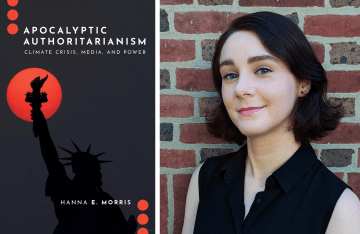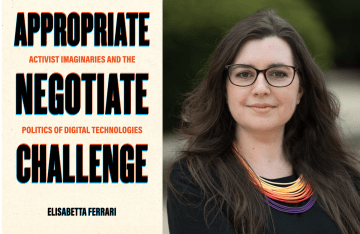Communication Major Alumna Q&A: Ashley Parker (C'05), White House Reporter for the Washington Post
Parker discusses how she got into journalism and what it's like to cover the Trump White House.

Ashley Parker
In celebration of the 40th anniversary of the Communication major at Penn, each Monday this semester we're running a series of Q&As with notable alumni. We kick off the series today with Ashley Parker (C'05).
Ashley Parker graduated from Penn in 2005. She is currently a White House reporter for The Washington Post. Previously, she worked for the New York Times for 11 years, where she covered the 2012 and 2016 presidential elections. Her work has appeared in the New York Times Magazine, Glamour's #51Million Project, the New York Sun, The Huffington Post, and more.
You landed a job at the New York Times right out of Penn. What was your path into journalism?
My path was slightly non-traditional, in that I landed at an amazing publication, but in a very entry level capacity. I started at the New York Times as Maureen Dowd’s research assistant — and because she was a great mentor, I was able to work my way up from there to a reporting job at the Times. Before that, I’d written for my high school paper and the Daily Pennsylvanian (DP), and had a bunch of internships — The New York Sun, The Gaithersburg Gazette, LIFE Magazine. And I’d written a cover story for Philadelphia Weekly while at Penn.
In what way did your time at Annenberg (and/or Penn) prepare you for that career path?
Leaving Penn — and Annenberg — I felt totally prepared (or as prepared as you can feel) to be an actual, working journalist. I think the DP — where I was a reporter and then an editor — as well as 34th Street Magazine were probably the best real life experience for actually reporting and writing. On deadline. Under pressure. But I also learned a ton in my classes, both the writing workshops I took at the Kelly Writers House as an English Major, and my Comms major. Some of my favorite Annenberg classes were with professional journalists and Washington experts, like Al Hunt and Peter Hart, and I also took two classes with Kathleen Hall Jamieson, then the dean of Annenberg. Not only was she an amazing professor — one of the few who could have a wait list for a class at the absolutely atrocious time of 2 to 5 pm on Friday afternoons — but I later profiled her for a writing class (which turned into a DP feature), and she’s now, along with Peter Hart, one of the smart voices I often call when I’m working on a story.
Life as a beat reporter at the New York Times or the Washington Post seems like it would be intense, but the onslaught of news coming out of the Trump White House must dial up the intensity to a whole new level. What is day-to-day life like for you behind the scenes?
I should say at the outset that this is the first White House I’ve covered, so I don’t have an official point of comparison. But I have covered campaigns before — Romney in 2012 and Jeb Bush and then Trump in 2016 — and the onslaught of news from the Trump White House is unlike anything I’ve ever experienced. My days starts, often, sometime between 6 and 7 am, when Trump starts Tweeting, and can end close to midnight. It helps that we have a great White House team of six reporters, so there’s some diffusion of responsibility, but if someone is off and someone else is traveling for a story, it can sometimes feel like an all hands on deck situation, depending on the news.
You’ve broken a number of bombshell scoops over the last couple of months. Are there pieces you’re particularly proud of?
I’m proud of a lot of the stories we’ve done that have gotten inside the White House and the president’s thinking in big moments — from the first day when Trump sent Sean Spicer out to lie about the crowd size to the day health care went down (for the first time) to the 24-hours when Trump almost withdrew from NAFTA to the decision to push out Reince Priebus. But most recently, I was really excited about the story we did explaining how Trump actually dictated his son’s misleading statement about his meeting with a Russian lawyer. And in general, I’m often most proud of the stories I do with some of my partners in crime here. The Post is an incredibly collegial and collaborative place, and I think that shows in a lot of our scoops, which bring in the knowledge, expertise, and sourcing of several top reporters. Finally — and this is not a scoop per say — but I liked the profile I did on Karen Pence, which had a fun detail that unexpectedly prompted dozens of think pieces about gender and marriage and sexism.
As someone who covers the Trump White House — and whose eyebrows have gone viral in the process — you’re at the epicenter of how social media is changing news. What role does Twitter play in your reporting?
Let’s just say I hope my eyebrows star turn is over. But I do use Twitter a lot, partially as a news feed just to keep up on all the latest stories and scoops — but also now because Twitter often offers a real time window into what the president is thinking at any given moment.
What advice would you share with Penn students thinking about journalism as a career?
Be able to handle rejection: It’s not easy, and it’s not supposed to be easy. (Or, at least, it wasn’t easy for me). I remember right when I started, I would pitch a story, wait forever to hear back from an editor, and then finally, if I was lucky, get a response… of no. (And I still remember the people who took the time to write me kind rejections.) Pretty soon, I started keeping a list of all the publications that might be interested in a story I wanted to do, and I would just go down the list — as soon as one publication said no, I’d move onto the next one, and then just relentlessly follow up (and follow up) until I got an answer.
Also: I have tons of advice and aphorisms I picked up from working for Maureen, but one (of many) that stuck with me was: It’s your byline on the story. So you need to fact check every single word, and make sure every phrase is just as you want it, because if you get pushed into something you’re uncomfortable with by an editor or a colleague, it’s still your name on that story and it’s your reputation that’s going to take the hit.
And finally: Always show up. I always think it is better to be somewhere in person, and to meet sources in person, even if means making a long drive you don’t want to make or taking a super early flight you don’t want to take. I’ve always found I’ve gotten better stuff — and details and sources and material I never even expected — when I’ve made the extra effort and shown up in person. There was a lot of consternation after the 2016 election about how so many reporters seemed to miss the Trump movement, and the Trump voter. And I think one of the reasons is that so many reporters “reported” on Trump without ever leaving New York or D.C. or even attending a single Trump event. Of course, there are many notable exceptions, including my colleague Jenna Johnson, who did — and still does — a wonderful job getting out in the country and chronicling the mood and what exactly Trump supporters are thinking.



